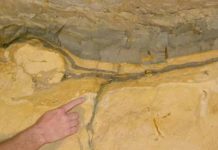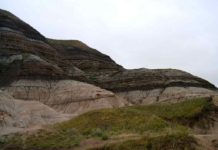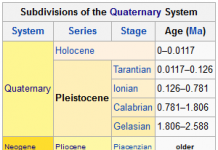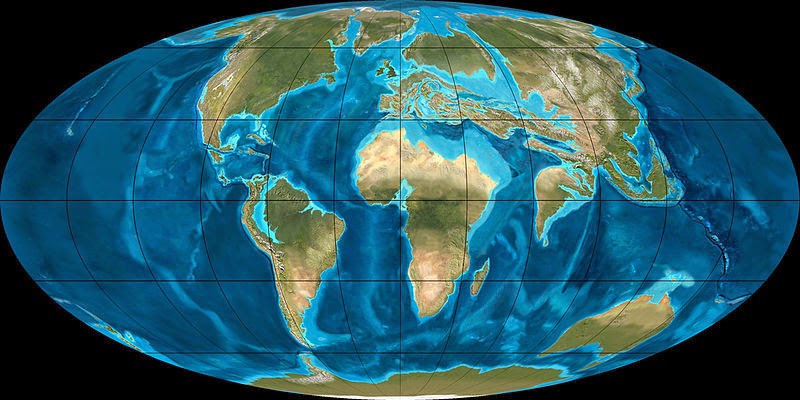
The Paleogene is a geologic period and system that began 66 and ended 23.03 million years ago and comprises the first part of the Cenozoic Era. Lasting 43 million years, the Paleogene is most notable as being the time in which mammals evolved from relatively small, simple forms into a large group of diverse animals in the wake of the Cretaceous–Paleogene extinction event that ended the preceding Cretaceous Period.
This period consists of the Paleocene, Eocene, and Oligocene Epochs. The end of the Paleocene (55.5/54.8 Mya) was marked by one of the most significant periods of global change during the Cenozoic, the Paleocene-Eocene Thermal Maximum, which upset oceanic and atmospheric circulation and led to the extinction of numerous deep-sea benthic foraminifera and on land, a major turnover in mammals. The Paleogene follows the Cretaceous Period and is followed by the Miocene Epoch of the Neogene Period. The terms ‘Paleogene System’ (formal) and ‘lower Tertiary System’ (informal) are applied to the rocks deposited during the ‘Paleogene Period’. The somewhat confusing terminology seems to be due to attempts to deal with the comparatively fine subdivisions of time possible in the relatively recent geologic past, when more information is preserved. By dividing the Tertiary Period into two periods instead of directly into five epochs, the periods are more closely comparable to the duration of ‘periods’ in the Mesozoic and Paleozoic Eras.
Climate and geography
The global climate during the Paleogene departed from the hot and humid conditions of the late Mesozoic era and began a cooling and drying trend which, although having been periodically disrupted by warm periods such as the Paleocene–Eocene Thermal Maximum, persists today. The trend was partly caused by the formation of the Antarctic Circumpolar Current, which significantly cooled oceanic water temperatures.The continents during the Paleogene continued to drift closer to their current positions. India was in the process of colliding with Asia, subsequently forming the Himalayas. The Atlantic Ocean continued to widen by a few centimeters each year. Africa was moving north to meet with Europe and form the Mediterranean, while South America was moving closer to North America (they would later connect via the Isthmus of Panama). Inland seas retreated from North America early in the period. Australia had also separated from Antarctica and was drifting towards Southeast Asia.
Flora and fauna
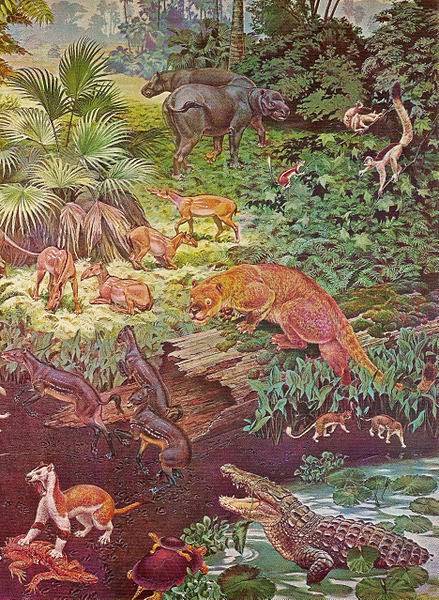
As the Earth began to cool, tropical plants were less numerous and were now restricted to equatorial regions. Deciduous plants became more common, which could survive through the seasonal climate the world was now experiencing. One of the most notable floral developments during this period was the evolution of the first grass species. This new plant type expanded and formed new ecological environments we know today as savannas and prairies. These grasslands also began to replace many forests because they could survive better in the drier climate typical in many regions of the world during this period.
Geology
The Paleogene is notable in the context of offshore oil drilling, and especially in Gulf of Mexico oil exploration, where it is usually referred to as the “Lower Tertiary”. These rock formations represent the current cutting edge of deep-water oil discovery.Lower Tertiary rock formations encountered in the Gulf of Mexico oil industry tend to be comparatively high temperature and high pressure reservoirs, often with high sand content (70%+) or under very thick salt sediment layers.[8]
Lower Tertiary explorations to date include (partial list):
- Kaskida Oil Field
- Tiber Oil Field
- Jack 2


